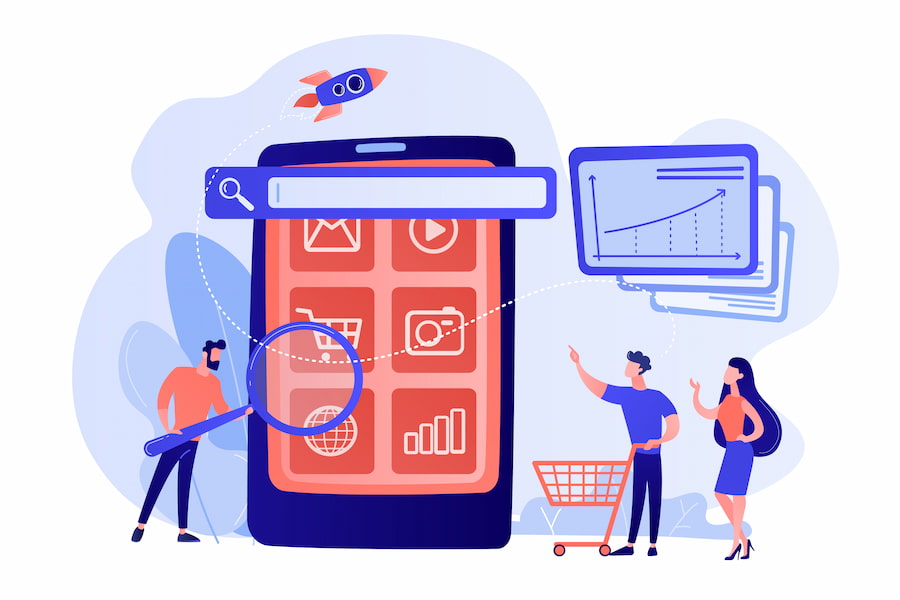In the continually expanding realm of e-commerce website development, the significance of Product Detail Pages (PDPs) cannot be overstated. They serve as a linchpin in luring visitors and transforming them into satisfied customers. A finely tuned PDP wields the power to profoundly influence a user’s purchase choices and, by extension, their shopping journey.
In this guide, we shall embark on a comprehensive exploration of real-world examples and industry best practices, all aimed at elucidating the art of crafting compelling and efficient e-commerce Product Detail Pages.

The Importance of Product Detail Pages
Product detail pages are the virtual counterparts of physical store shelves in e-commerce. Much like how customers peruse store shelves to inspect products in a traditional brick-and-mortar store, these pages are where potential online customers converge to gather essential information about a product. Here, they engage in a critical evaluation process, assessing its suitability for their needs and ultimately determining whether to proceed with a purchase.
In essence, a well-constructed PDP serves as a bridge between the customer and the product. It provides comprehensive information and addresses any questions and concerns a user may have. Moreover, it is pivotal in instilling confidence in potential buyers, guiding them through decision-making, and facilitating a seamless transition from browsing to conversion.
13 Essential Elements of a Product Detail Page – With Best Practices

1. Product Title
Keep the product title concise and descriptive. Include relevant keywords to improve search engine optimization (SEO).
The product title is the first element users encounter on a product detail page (PDP). It plays a crucial role in grabbing attention and conveying essential information about the product. Here’s why keeping it concise and descriptive is a best practice:
- Clarity: A concise and descriptive title ensures that users immediately understand the product
- SEO Optimization: Including relevant keywords in the title can enhance the PDP’s visibility in search engine results, making it more discoverable.
Example: “Apple iPhone 13 Pro Max – 256GB – Graphite”
The example provided, “Apple iPhone 13 Pro Max – 256GB – Graphite,” follows this best practice effectively. It briefly presents the product’s brand, model, variant (storage capacity), and color.
2. Product Images
Provide multiple high-resolution images that showcase the product from various angles and contexts. Enable zooming for a closer look.
Product images are the visual centerpiece of a PDP. They serve as a virtual showroom for customers, allowing them to examine the product closely before purchasing. Here’s why providing high-quality images with zooming capability is crucial:
- Visual Appeal: High-resolution images enhance the product’s visual appeal and provide a sense of quality and professionalism.
- Detailed Examination: Enabling zooming allows users to inspect intricate details, textures, and fine print, replicating the in-store experience.
- Contextual Presentation: Showcasing the product from various angles and in different contexts helps users understand its appearance and scale.
Amazon excels in this aspect, particularly in its PDPs for electronics. They typically offer multiple high-resolution images, including 360-degree views and zoom functionality, allowing customers to examine products comprehensively.
3. Product Description
Write a clear, informative, and engaging product description. Use bullet points to highlight key features and benefits. Avoid jargon and provide specifications.
The product description is where you provide detailed information about the product. A well-crafted description can influence purchasing decisions. Here’s why writing a clear, informative, and engaging product description is essential:

- Information Clarity: A clear and informative description answers potential questions and provides a complete understanding of the product.
- Highlighting Benefits: Using bullet points to emphasize key features and benefits makes it easier for users to grasp the product’s value.
- User-Friendly Language: Avoiding technical jargon ensures that the description is accessible to many customers.
4. Pricing Information
Display the price prominently near the product title. Use striking visuals to highlight discounts or savings. If applicable, provide flexible payment options.
The pricing information is a critical element of a PDP, directly impacting a user’s purchasing decision. Here’s why displaying the price prominently and effectively is important:
- Transparency: Displaying the price builds customer trust and ensures transparency.
- Discount Visibility: Using striking visuals and icons to highlight discounts or savings can influence users to purchase.
- Flexible Payment: If possible, offering flexible payment options, such as installment plans or financing, can cater to a broader customer base.
Example: Walmart often uses bold pricing displays with attention-catching icons for discounts and savings.
Walmart’s PDPs often feature bold pricing displays, thus making an essential piece of information easy to locate. Additionally, attention-catching icons that communicate discounts and savings make it easier for customers to understand the value proposition. making it easier for customers to understand the value proposition.
5. Product Variants
Present variant options (e.g., size, color) with dropdown menus or swatches. Update images to reflect the selected variant.
For products with multiple variants, such as different sizes or colors, presenting these options is essential for a smooth shopping experience. Here’s why providing clear variant options is necessary:
- User-Friendly Selection: Dropdown menus or swatches make it easy for users to choose their preferred variant.
- Visual Confirmation: Real-time image updates based on the selected variant provide visual confirmation, reducing uncertainty.
- Efficiency: Clear variant selection reduces the likelihood of users leaving the PDP due to confusion.
Example: Nike‘s website is a prime example of an effective variant presentation. It allows users to select different shoe sizes and colors seamlessly, updating images in real-time to reflect the chosen variant.

6. Customer Reviews and Ratings
Showcase authentic customer reviews and ratings. Implement a review filtering system and allow customers to leave detailed feedback.
Customer reviews and ratings provide social proof and valuable insights into the product’s quality and performance. Here’s why showcasing authentic reviews is important:
- Trust Building: Genuine reviews build trust by offering unbiased opinions from other customers.
- Informed Decisions: Reviews help potential buyers make informed decisions based on the experiences of others.
- Feedback for Improvement: Customer feedback can provide insights for product improvement.
Example: Amazon’s extensive use of customer reviews and ratings provides valuable insights for potential buyers.
6. Customer Reviews and Ratings
Showcase authentic customer reviews and ratings. Implement a review filtering system and allow customers to leave detailed feedback.
Customer reviews and ratings provide social proof and valuable insights into the product’s quality and performance. Here’s why showcasing authentic reviews is important:
- Trust Building: Genuine reviews build trust by offering unbiased opinions from other customers.
- Informed Decisions: Reviews help potential buyers make informed decisions based on the experiences of others.
- Feedback for Improvement: Customer feedback can provide insights for product improvement.
Example: Amazon’s extensive use of customer reviews and ratings provides valuable insights for potential buyers.
7. Shipping Information
Communicate shipping options, estimated delivery times, and costs. Offer expedited shipping for those willing to pay extra.
Shipping information is critical as it directly affects a user’s decision-making process. Here’s why providing clear shipping details is useful:
- Expectation Management: Clear communication of shipping options and estimated delivery times helps manage user expectations.
- Cost Transparency: Informing users about shipping costs, especially if there are additional fees, prevents surprises during checkout.
- Choice Offerings: Offering expedited shipping for those seeking quicker delivery can be an added incentive.
Example: Best Buy excels in providing estimated delivery times and shipping options directly on their PDPs, ensuring that customers clearly understand the shipping process.

8. Return Policy
Present your return and refund policy clearly and transparently. Include any relevant deadlines or conditions.
A clear and customer-friendly return policy can instill confidence in users. Here’s why presenting the return policy transparently is essential:
- Confidence Building: A generous and transparent return policy reassures users, reducing buyer remorse concerns.
- Clarity: Clearly stating any deadlines or conditions for returns prevents misunderstandings.
- Competitive Advantage: A favorable return policy can be a competitive advantage, especially in e-commerce.
Example: Zappos is known for its generous 365-day return policy, which it prominently displayed on its product pages. This approach builds trust and confidence among customers, and helps differentiate the brand from its competitors.
9. Add to Cart/Buy Now Button
Make the CTA button stand out with contrasting colors and clear, action-oriented language.
The Call-to-Action (CTA) button is the gateway to conversion. Making it prominent and compelling is essential for driving sales. Here’s why an effective CTA button is important:
- Conversion Focus: A well-designed CTA button encourages users to take the desired action, whether adding the product to the cart or making an immediate purchase.
- Visibility: Using contrasting colors and clear language ensures that the CTA button stands out on the page.
- Simplicity: Action-oriented language (e.g., “Buy Now” or “Add to Cart”) leaves no room for ambiguity.
Example: Apple’s PDPs are a prime example of this best practice, with a prominent “Buy” button that easily stands out amongst the overall design, directing the user’s attention towards the next step.

10. Related Products
Suggest related or complementary products based on the user’s current selection to encourage upselling and cross-selling.
Offering related or complementary products can enhance the shopping experience and boost revenue. Here’s why suggesting related products is valuable:
- Customer Convenience: Users may appreciate product recommendations that complement their selection.
- Upselling Opportunity: Suggesting higher-priced alternatives or accessories can lead to higher order values.
- Cross-selling potential: Encouraging users to explore related categories can expand their purchase scope.
Example: On eBay, users are presented with related accessories and lenses when viewing a camera.
11. Social Sharing Buttons
Include social sharing buttons to encourage users to share the product with their network, expanding your product’s reach.
Social sharing buttons allow users to promote products to their social networks, potentially increasing visibility and sales. Here’s why incorporating these buttons is beneficial:
- Amplified Reach: Users sharing products with their networks can increase exposure and lead to potential new customers.
- User Engagement: Sharing buttons encourage interaction with the product, enhancing the user experience.
- Viral Potential: Viral sharing can lead to exponential growth in product awareness.
Example: Etsy incorporates social sharing buttons on its product pages, making it easy for users to share unique finds.
12. Product Availability
Indicate whether the product is in stock, on backorder, or available for pre-order to manage user expectations.
Informing users about product availability is vital to manage their expectations and prevent disappointment. Here’s why indicating availability is essential:
- Preventing Frustration: Users appreciate knowing whether a product is in stock to avoid disappointment during checkout.
- Timely Decision-Making: Availability information allows users to make informed decisions, especially if a product is on backorder or available for pre-order.
- Stock Monitoring: Real-time stock availability updates can help users gauge urgency.
Example: Many Shopify-powered stores display real-time stock availability, ensuring that customers are well-informed about the current status of the product.

display real-time stock availability, ensuring that customers are well-informed about the current status of the product.
13. Size Guides and Measurements
Provide size charts and measurements for apparel and accessories to help users choose the right size.
Providing size guides and measurements is crucial for products like apparel and accessories to help users make the right choices. Here’s why offering size guides is necessary:
- Fit Assurance: Size charts and measurements reduce the likelihood of returns due to incorrect sizing.
- Customer Confidence: Users are more likely to purchase when they can confidently select the right size.
- Enhanced Shopping Experience: Size guides provide a seamless and user-friendly shopping experience.
Example: ASOS offers size guides for clothing, shoes, and accessories, enhancing the online shopping experience.
Conclusion
Creating effective e-commerce product detail pages is crucial to online retail success. By implementing these best practices and drawing inspiration from successful examples, you can create PDPs that engage customers, boost conversions, and enhance the shopping experience. Remember that ongoing testing and optimization are essential to adapt to evolving user preferences and market trends in the dynamic world of e-commerce.
